

MakerBot Digitizer Lets You Turn Objects Into 3D Models for $1400. MakerBot has opened up pre-orders for MakerBot Digitizer Desktop 3D Scanner, a laser-equipped 3D scanner that lets you easily convert real-life objects into 3D models.

The device, originally announced in March at SXSW, costs $1,400 plus an optional $150 for MakerBot's service and support program called the Digitizer MakerCare. Shipping is expected in "mid-October". MakerBot Digitizer uses two lasers and a camera to scan objects up to 8 inches tall and 8 inches in diameter, and turn them into a number of standard 3D design file formats. The entire process takes "minutes" and doesn't require design or 3D software experience. Nanotechnology Printer On The Horizon. Desktop printers are advancing in revolutionary ways, from 3-D printers that could in principle help manufacture robots at home to cell-placing biotechnological machines that researchers hope could one day fabricate organs on demand.
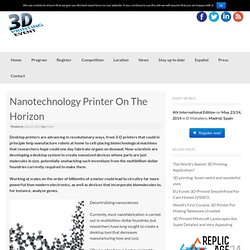
Now scientists are developing a desktop system to create nanosized devices whose parts are just molecules in size, potentially unshackling such inventions from the multibillion-dollar foundries currently required to make them. Working at scales on the order of billionths of a meter could lead to circuitry far more powerful than modern electronics, as well as devices that incorporate biomolecules to, for instance, analyze genes. Decentralizing nanosciences. 3D-Printed Fashion Show Draws Inspiration From Nature. When you think about it, the fashion and tech industries aren't so different.
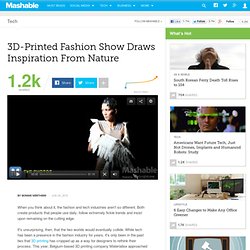
Both create products that people use daily, follow extremely fickle trends and insist upon remaining on the cutting edge. It's unsurprising, then, that the two worlds would eventually collide. While tech has been a presence in the fashion industry for years, it's only been in the past two that 3D printing has cropped up as a way for designers to rethink their process. This year, Belgium-based 3D printing company Materialise approached fashion designer Melinda Looi, who has won numerous awards for her experimental designs, to design a collection for Asia's first 3D-printed fashion show.
"Creating fashion with technology has always been something I wanted to do," Looi told Fast Company. With the help of Materialise and a few engineers, Looi designed a collection inspired by birds, consisting of winged accessories and patterns that echo natural forms. 3D-printed fashion accessory or new-age Bluetooth headpiece? Makerbot Updates Their Design Software And Firmware To Make 3D Printing Easier. Makerbot, besides making a darn nice printer, offers some amazing software for laying out and printing objects.
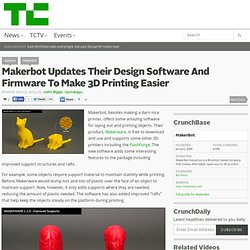
Their product, Makerware, is free to download and use and supports some other 3D printers including the FlashForge. The new software adds some interesting features to the package including improved support structures and rafts. For example, some objects require support material to maintain stability while printing. Before, Makerware would dump lots and lots of plastic over the face of an object to maintain support. Move over 3D printing, self-assemblng 4D-printed materials are on the way. Molecular self-assembly, whereby molecules position themselves into defined arrangements, is commonplace in biological systems and nanotechnology.
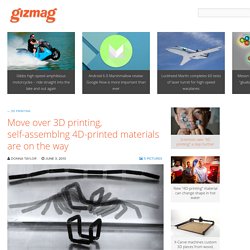
But researchers at MIT are working on so called "4D printing" technology that aims to bring the process up to the macro scale, enabling 3D-printed materials to be programmed to self-assemble into predefined shapes and structures. The New “Handmade” (Part Three) Consumer interest in 3D printing is booming, thanks to increasingly affordable printers, crazy stories about 3D-printed candy, human ears and handguns, all of which are impressive technological leaps.
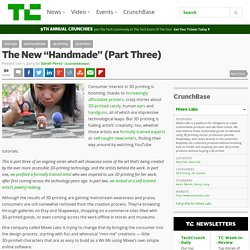
But 3D printing is fueling artists’ creativity, too, whether those artists are formally trained experts or self-taught newcomers, finding their way around by watching YouTube tutorials. This is part three of an ongoing series which will showcase some of the art that’s being created by the ever more accessible 3D-printing technology, and the artists behind the work. The Pirate3D Buccaneer Printer Will Cost $347, Is Hitting Kickstarter Shortly. Welcome to the world of the sub-$1,000 3D printer.
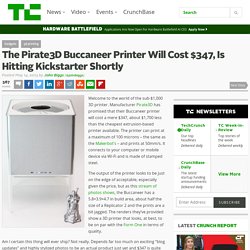
Manufacturer Pirate3D has promised that their Buccaneer printer will cost a mere $347, about $1,700 less than the cheapest extrusion-based printer available. The printer can print at a maximum of 100 microns – the same as the Makerbot’s – and prints at 50mm/s. It connects to your computer or mobile device via Wi-Fi and is made of stamped steel. 3D Printing Doesn't Live Up To The Hype Yet. Consumer Tech Is Doomed! Comparing the promises made in the Geneva agreement on April 17 to the actions on the ground in the ten days since gives a good idea which side is the bigger liar.

DONETSK, Ukraine -- In the war of words between Washington and Moscow—a rhetorical clash that is descending to personal insults – both sides are determined to prove they are in the right in an information war waged at a Twitter-driven speed that would have made the heads of their Cold War predecessors spin. But who is telling the truth? Below is The Daily Beast’s checklist on the Geneva agreement that is the closest thing we have as a touchstone for gauging reality. Diplomats drawn from Russia, Ukraine, the United States and the European Union hammered out the accord on April 17. Urbee 2 Is the 3D Printed Car of the Future. We've already seen all kinds of 3D-printed items, from jewelry, to guitars, and even football cleats.
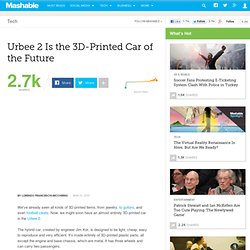
Now, we might soon have an almost entirely 3D-printed car in the Urbee 2. The hybrid car, created by engineer Jim Kor, is designed to be light, cheap, easy to reproduce and very efficient. It's made entirely of 3D-printed plastic parts, all except the engine and base chassis, which are metal. It has three wheels and can carry two passengers. Currently, it takes almost three months for the car to be printed and assembled. The Urbee team is also very focused on safety. 3-D Printed Car Is as Strong as Steel, Half the Weight, and Nearing Production. Engineer Jim Kor and his design for the Urbee 2.
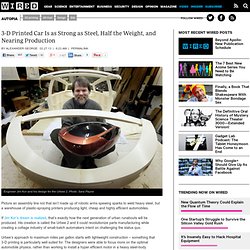
Photo: Sara Payne Picture an assembly line not that isn’t made up of robotic arms spewing sparks to weld heavy steel, but a warehouse of plastic-spraying printers producing light, cheap and highly efficient automobiles. If Jim Kor’s dream is realized, that’s exactly how the next generation of urban runabouts will be produced. His creation is called the Urbee 2 and it could revolutionize parts manufacturing while creating a cottage industry of small-batch automakers intent on challenging the status quo.
How Big Business is Stymying Makers' High-Res, Colorful Innovations. If you're waiting for desktop additive-manufacturing technology to move closer to professional-level results, be prepared to wait for a very long time. The past year was a breakout for desktop 3-D printing. MakerBot released two new models, Formlabs debuted the first prosumer 3-D printer to use high-accuracy stereolithography, and a slew of innovative, printed projects lifted awareness and desirability of additive manufacturing for the general public. But the year ended with a legal hiccup.
Formlabs will be dealing with a patent infringement lawsuit brought against them by 3D Systems, one of the biggest players in the industry.
Bootstrapping a 3D Printed Design is Profitable. The biggest question in my head for years has been this. Can you start a business with a desktop 3D printer? With a nice little Makerbot, or a RepRap and a really useful product design, can I actually be my own, cigar-sucking factory boss? In my own living room, with a bathrobe on? An intriguing thought, but do the numbers support such a possibility? As evidence show: YES! They decided to test the hypothesis of whether or not an entrepreneur can bootstrap their business by buying a cheap 3D printer and selling their one design. The part costs was a mere $13.40, roughly 60% of the full $19.95 price tag. Between December 2010 and September 2011, 42 orders of 51 Trik Adapters were printed by their Makerbot, plus 56 that were outsourced. Their conclusion was pretty simple. Printing Nano-Electronics on Everything: Phones, Planes, Fish Tanks.
Imagine you could print a thin layer of micro-electronics on any surface. With 3D printing, this is now a reality – reports the Economist – and that makes any surface a smart surface. It’s not traditional copper, but rather micro-building blocks of silver. A home 3D printer to turn your ideas into real objects. uPrint Personal 3D Printer - Graphics Systems Corp. Will We 3D Print the First Moon Base Using Lunar Soil? It’s exciting that in recent years a host of serious projects are being launched, directed at the goal of colonizing another planet in the solar system. From the groundbreaking Curiosity rover exploring the surface of Mars, to the reality TV funded Mars One project, the world is pushing hard to put the first permanent inhabitants on the surface of another world. Now Enrico Dini, the inventor of a massive 3D printer called D-Shape, is teaming up with the European Space Agency and building innovator Foster + Partners in an attempt to solve one of the most challenging aspects of colonizing another planet: lifting a heavy habitat off earth and getting it there.
The team’s inspired solution doesn’t deliver a habitat from earth at all. Instead they are looking to use Enrico Dini’s 3D printer to construct buildings on site using the local soil as its printing material. “Our current printer builds at a rate of around two meters per hour,” Dini tells Co. Via fastcodesign. As Patent Drama Continues, 3D Printing Provides A Way Out For Mashup Creators. Editor’s note: Michael Weinberg is vice president at Public Knowledge where he focuses primarily on copyright, issues before the FCC and emerging technologies like 3D printing. Follow him on Twitter @mweinbergPK. Mashups are one of the great art forms of our time. Easy and accessible digital tools have allowed anyone to remix videos, music and photographs into their own original works: Mashup culture has produced fantastic music, critical video, and delightful cultural artifacts of all kinds. However, mashups are ultimately limited by the nature of their source material.
The types of things that mashups draw from – videos, music, photos – are also the types of things that are protected by copyright, which means mashup creators need to take copyright into account when creating their works.